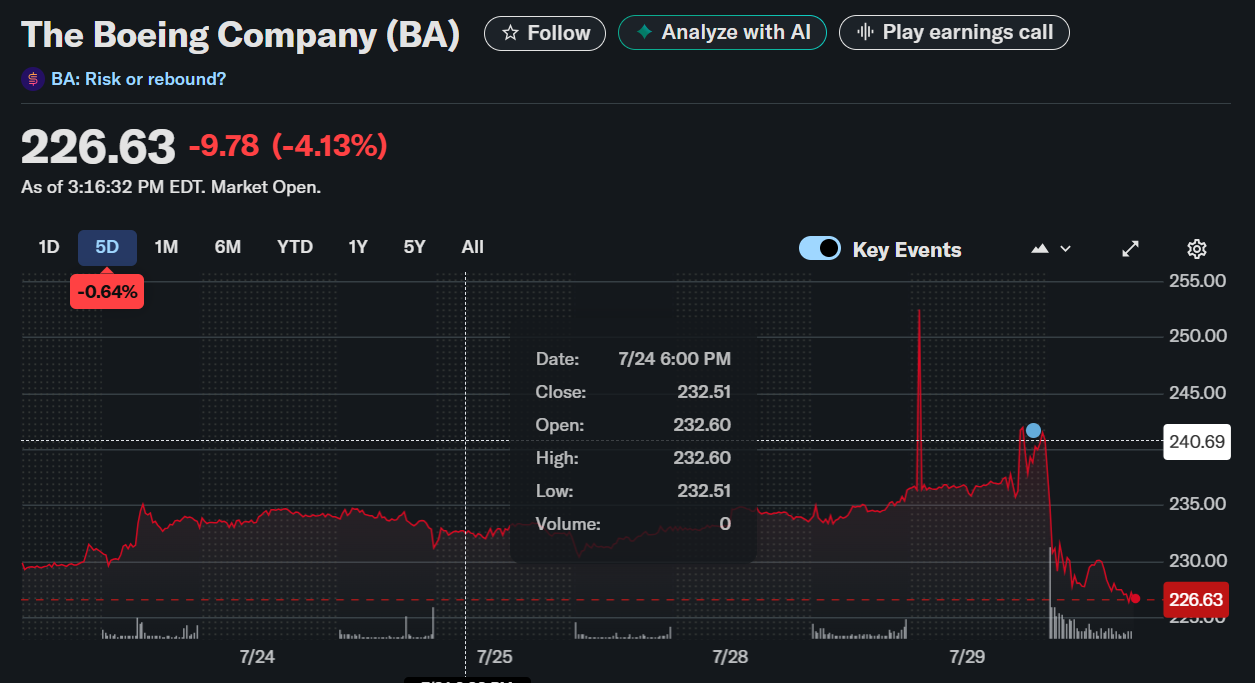TLDR:
- Boeing reported Q2 revenue of $22.75B, beating estimates by 5.3% and up 34.9% YoY
- Adjusted EPS loss of $1.24 beat the consensus of -$1.31
- Operating margin improved to -0.8%, a major recovery from -6.5% last year
- Cash burn slashed to $200M from $4.3B year-ago
- CEO Kelly Ortberg signals 2025 as Boeing’s turnaround year
On July 30, 2025, Boeing (NYSE: BA) reported second-quarter earnings that surpassed analyst expectations on revenue, while showing marked improvement across several critical financial metrics. The stock was last seen trading at $227.46, down 3.79% in midday trading.

Revenue reached $22.75 billion, topping Wall Street’s forecast of $21.67 billion and representing a 34.9% year-over-year gain. Adjusted EPS came in at a loss of $1.24, a smaller loss than the anticipated -$1.31. Operating margin was -0.8%, up significantly from -6.5% during the same quarter last year. Boeing also reported that its backlog had swelled to $618.5 billion, signaling sustained demand across commercial and defense segments.
Sharp Cut in Cash Burn
Perhaps most notably, Boeing slashed its cash burn to $200 million in Q2, a stark improvement from $4.3 billion burned in the same period a year ago and $2.3 billion in Q1 2025. During the earnings call, executives said they expect Q3 cash flow to remain similar, excluding legal settlements. CEO Kelly Ortberg noted confidence in finishing 2025 with positive cash flow.
CEO Ortberg’s Turnaround Strategy
Ortberg, who took over as CEO in August, has positioned 2025 as Boeing’s “turnaround year.” Following the turbulent fallout from the 2024 Alaska Airlines 737 Max incident and ongoing supply chain issues, Ortberg implemented a deliberate production slowdown to address quality control problems.
Jet deliveries rose to 150 in Q2, up from 130 in Q1 and 92 a year ago. These included 102 737 Max, 24 Dreamliner 787s, 13 777s, and nine 767s. Boeing’s goal remains to reach 42 Max jets per month by midyear and potentially raise that to 47 per month by year-end.
Financial Trends and Analyst Outlook
Despite recent improvements, Boeing’s long-term financial metrics highlight past struggles. EPS has fallen at a 19.3% CAGR over five years and declined 33.8% annually over the past two years. Nonetheless, analysts forecast a return to profitability in 2026, with full-year EPS flipping from a loss of $17.95 to a gain of $1.34.
Revenue projections for the next 12 months imply a 19.8% increase, suggesting confidence in product ramp-ups and operational stability. While profitability remains elusive, the narrowing of losses and stronger sales signal progress.
Conclusion
Boeing’s Q2 2025 results exceeded expectations and underscored tangible signs of recovery. With increased jet deliveries, reduced cash burn, and a strategic turnaround led by Ortberg, the company appears to be stabilizing after a tumultuous year. Still, investors remain cautious, as shares slid in midday trading despite positive news. Boeing’s next quarters will be crucial in proving its recovery is on a sustainable footing.






